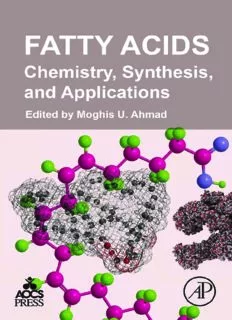
Fatty Acids: Chemistry, Synthesis, and Applications PDF
Preview Fatty Acids: Chemistry, Synthesis, and Applications
Fatty Acids This pageintentionallyleftblank Fatty Acids Chemistry, Synthesis, and Applications Edited by Moghis U. Ahmad JinaPharmaceuticals, Inc.,Libertyville, IL,UnitedStates AcademicPressandAOCSPress AcademicPressisanimprintofElsevier 125LondonWall,LondonEC2Y5AS,UnitedKingdom 525BStreet,Suite1800,SanDiego,CA92101-4495,UnitedStates 50HampshireStreet,5thFloor,Cambridge,MA02139,UnitedStates TheBoulevard,LangfordLane,Kidlington,OxfordOX51GB,UnitedKingdom Copyrightr2017AOCSPress.PublishedbyElsevierInc.Allrightsreserved. PublishedincooperationwithAmericanOilChemists’Societywww.aocs.orgDirector,Content Development:JanetBrown. Nopartofthispublicationmaybereproducedortransmittedinanyformorbyanymeans,electronicor mechanical,includingphotocopying,recording,oranyinformationstorageandretrievalsystem,without permissioninwritingfromthepublisher.Detailsonhowtoseekpermission,furtherinformationaboutthe Publisher’spermissionspoliciesandourarrangementswithorganizationssuchastheCopyrightClearance CenterandtheCopyrightLicensingAgency,canbefoundatourwebsite:www.elsevier.com/permissions. ThisbookandtheindividualcontributionscontainedinitareprotectedundercopyrightbythePublisher (otherthanasmaybenotedherein). Notices Knowledgeandbestpracticeinthisfieldareconstantlychanging.Asnewresearchandexperiencebroaden ourunderstanding,changesinresearchmethods,professionalpractices,ormedicaltreatmentmaybecome necessary. Practitionersandresearchersmustalwaysrelyontheirownexperienceandknowledgeinevaluatingand usinganyinformation,methods,compounds,orexperimentsdescribedherein.Inusingsuchinformationor methodstheyshouldbemindfuloftheirownsafetyandthesafetyofothers,includingpartiesforwhomthey haveaprofessionalresponsibility. Tothefullestextentofthelaw,neitherthePublishernortheauthors,contributors,oreditors,assumeany liabilityforanyinjuryand/ordamagetopersonsorpropertyasamatterofproductsliability,negligenceor otherwise,orfromanyuseoroperationofanymethods,products,instructions,orideascontainedinthe materialherein. BritishLibraryCataloguing-in-PublicationData AcataloguerecordforthisbookisavailablefromtheBritishLibrary LibraryofCongressCataloging-in-PublicationData AcatalogrecordforthisbookisavailablefromtheLibraryofCongress ISBN:978-0-12-809521-8 ForInformationonallAcademicPresspublications visitourwebsiteathttps://www.elsevier.com/books-and-journals Publisher:Andre´G.Wolff AcquisitionEditor:NancyMaragioglio EditorialProjectManager:BillieJeanFernandez ProductionProjectManager:LisaJones CoverDesigner:VictoriaPearson TypesetbyMPSLimited,Chennai,India Contents ListofContributors xvii MeettheEditor xix Preface xxi 1. History of Fatty Acids Chemistry GaryR.List,JamesA.KenarandBryanR.Moser 1.1 Introduction 2 1.2 EarlyFattyAcidHistory 2 1.3 MajorDevelopmentsintheOleochemicalIndustry 9 1.3.1 FatSplitting 9 1.3.2 CatalyticHydrogenation 10 1.3.3 FattyAcidDistillation 11 1.3.4 FattyAlcohols 11 1.3.5 Estolides 12 1.3.6 DimerandTrimerCyclicFattyAcids 13 1.3.7 HydroformylationofFattyAcids 14 1.3.8 OzonolysisofFattyAcidsandTriglycerides 14 1.4 ContributionsofAnalyticalChemistrytoFattyAcids 15 1.5 RecentDevelopmentsinFattyAcids 16 1.6 Conclusion 17 References 18 2. Naturally Occurring Fatty Acids: Source, Chemistry, and Uses JamesA.Kenar,BryanR.MoserandGaryR.List 2.1 Introduction 24 2.2 ProductionofNaturallyOccurringFattyAcids 28 2.2.1 ChemicalSplitting 29 2.2.2 LipaseSplitting 30 2.3 PurificationofFattyAcids 31 2.3.1 SimpleDistillation 31 2.3.2 FractionalDistillation 32 2.3.3 MolecularDistillation 35 2.3.4 Crystallization 35 2.3.5 UreaFractionation 36 v vi Contents 2.4 SourcesandTypesofNaturallyOccurringFattyAcids 37 2.4.1 SaturatedFattyAcids 38 2.4.2 UnsaturatedFattyAcids 39 2.4.3 HydroxyFattyAcids 43 2.4.4 AcetylenicFattyAcids 45 2.4.5 AllenicandCumulenicFattyAcids 47 2.5 ChemistryofNaturallyOccurringFattyAcids 49 2.5.1 ReactionsattheCarboxylicAcidGroup 50 2.5.2 ReactionsatUnsaturatedSites 57 2.6 Conclusion 71 References 71 3. Epoxy Fatty Acids: Chemistry and Biological Effects ArnisKuksisandWaldemarPruzanski 3.1 Introduction 83 3.2 NaturalOccurrenceandStructureofEpoxyFattyAcids 84 3.2.1 OleicandLinoleicAcidMonoepoxidesandHydroxides 84 3.2.2 ArachidonicAcidMonoepoxides 85 3.2.3 EicosapentaenoicAcidandDocosahexaenoicAcid Monoepoxides 85 3.3 ChemicalSynthesis 88 3.3.1 DirectEpoxidation 88 3.3.2 Chemo-EnzymaticPerhydrolysis 89 3.3.3 OtherChemo-EnzymaticEpoxidations 90 3.4 BiosynthesisofEpoxyFattyAcids 90 3.4.1 OxygenasesandLipoxygenases 91 3.4.2 Peroxygenases 91 3.4.3 CytochromeP450-LikeOxygenases 92 3.5 AnalysisofEpoxyFattyAcids 94 3.5.1 ResolutionofRegioisomers 95 3.5.2 ResolutionofEnantiomers 97 3.5.3 GC/MSandLC/MSIdentificationofLipidEpoxides 103 3.6 BiologicalEffects 104 3.6.1 LipidSignaling 104 3.6.2 CellularEffects 105 3.6.3 SystemicEffects 107 3.7 PathologicalEffects 108 3.7.1 Toxicity 108 3.7.2 InflammationandPain 108 3.7.3 AngiogenesisandCardiovascularDisease 110 3.7.4 Cancer 111 3.8 Conclusion 112 Abbreviations 112 References 113 Contents vii 4. Acetylenic Epoxy Fatty Acids: Chemistry, Synthesis, and Their Pharmaceutical Applications ValeryM.DembitskyandDmitryV.Kuklev 4.1 Introduction 121 4.2 OccurrenceEpoxyAcetylenicFattyAcidsinNature 122 4.3 LipidsContainingEpoxyAcetylenicFattyAcids 125 4.4 EpoxyAcetylenicFuranoidandThiopheneFattyAcidand Derivatives 128 4.5 PyranoneandMacrocyclicEpoxides 129 4.6 AcetylenicCyclohexanoidEpoxyFattyAcids 130 4.7 DeterminationorEpoxyAcetylenicLipids 131 4.8 SynthesisofEpoxyAcetylenicLipids 136 4.9 ConcludingRemarks 141 References 142 FurtherReading 146 5. Carbocyclic Fatty Acids: Chemistry and Biological Properties MoghisU.Ahmad,ShoukathM.Ali,AteeqAhmad, SaifuddinSheikhandImranAhmad 5.1 Introduction 148 5.2 NaturallyOccurringCyclopropeneFattyAcids 150 5.2.1 TheHalphenTest 151 5.2.2 IsolationofCyclopropeneFattyAcidsFromSeedOils 152 5.2.3 ChemicalCharacterization 152 5.3 SynthesisandCharacterizationofSterculicAcid 156 5.3.1 CharacterizationofDihydrosterculicAcid 158 5.3.2 TotalSynthesisofcis-CyclopropaneFattyAcids 160 5.3.3 DeuteratedCyclopropeneFattyAcids 161 5.4 BiosynthesisofCyclopropaneandCyclopropeneFattyAcids 163 5.5 MassSpectrometryofCyclopropeneFattyAcids 165 5.5.1 GasChromatography-MassSpectrometryAnalysisof CyclopropeneFattyAcids 166 5.5.2 GasChromatography-MassSpectrometryAnalysisof CyclopropaneFattyAcids 171 5.6 PhysiologicalPropertiesofCyclopropeneFattyAcids 171 5.7 CyclopropaneoctanoicAcid2-HexylinHumanAdipose TissueandSerum 173 5.7.1 CyclopropaneoctanoicAcid2-HexylinPatientsWith Hypertriglyceridemia 175 5.8 LeishmaniaCyclopropaneFattyAcidSynthetase 176 5.8.1 Leishmania:AFungalInfection 177 5.9 Conclusion 178 References 179 FurtherReading 185 viii Contents 6. Modification of Oil Crops to Produce Fatty Acids for Industrial Applications JohnL.Harwood,HelenK.Woodfield,GuanqunChen andRandallJ.Weselake 6.1 Introduction 188 6.2 KeyAspectsofPlantOilBiosynthesis 189 6.3 MajorOilCrops 194 6.3.1 OilPalm(Elaeisguineensis) 194 6.3.2 Soybean(Glycinemax) 197 6.3.3 BrassicaOilseedSpecies(Brassicanapus,Brassicarapa, Brassicaoleracea,Brassicacarinata) 201 6.3.4 Sunflower(Helianthusannuus) 206 6.4 MinorOilCrops 208 6.4.1 Alfalfa(Medicagosativa,Medicagofalcata) 209 6.4.2 Almond(Prunusdulcis,Prunusamygdalus,Amygdalus communis) 209 6.4.3 Avocado(Perseaamericana,Perseagratissima) 209 6.4.4 Blackcurrant(Ribesniger) 209 6.4.5 Borage(Boragoofficinalis) 209 6.4.6 BorneoTallow(Shoreastenoptera) 209 6.4.7 Camelina(Camelinasativa)(Section6.5Also) 211 6.4.8 Castor(Ricinuscommunis) 211 6.4.9 Cocoa(Theobromacacao) 211 6.4.10 Coconut(Cocosnucifera) 212 6.4.11 Coriander(Coriandrumsativum) 212 6.4.12 Cottonseed(Gossypiumhirsutum,Gossypium barbadense) 212 6.4.13 Crambe(Crambeabyssinica,Crambehispanica) (Section6.5Also) 212 6.4.14 Cupheaspp. 212 6.4.15 Dimorphotheca(Dimorphothecapluvialis) 213 6.4.16 Echium(Echiumplantagineum) 213 6.4.17 Flax(Linumusitatissimum) 213 6.4.18 Hazelnut(Corylusavellana) 213 6.4.19 Jatrophacurcas(SeeSection6.5) 213 6.4.20 Jojoba(Simmondsiachinensis) 214 6.4.21 Lesquerella(Lesquerellafendleri)(SeeSection6.5) 214 6.4.22 Maize(Corn;Zeamays) 215 6.4.23 Meadowfoam(Limnanthesalba) 215 6.4.24 Mustard(Brassicaalba,Brassicacarinata,Brassicahirta, Brassicajuncea,Brassicanigra) 215 6.4.25 Oats(Avenasativa) 215 6.4.26 Olive(Oleaeuropaea) 215 6.4.27 Peanut(GroundNut,Arachishypogaea) 216 6.4.28 PineNuts(Pinusspp.) 216 6.4.29 Poppy(Papaversomniferum) 216 Contents ix 6.4.30 Rice(Oryzasativa)BranOil 216 6.4.31 Safflower(Carthamustinctorius) 217 6.4.32 Shea(Butyrospermumparkii,SheaButter,KarateButter) 217 6.4.33 Tall 217 6.4.34 Tung(Aleuritesfordii) 217 6.4.35 VernoniaOils 218 6.5 EmergingIndustrialOilCrops 218 6.6 ProspectsforProductionofIndustrial OilsinVegetativeTissue 222 Acknowledgments 223 References 223 FurtherReading 236 7. Microbial Production of Fatty Acids ColinRatledgeandCaseyLippmeier 7.1 Introduction 237 7.2 TheProcessofLipidAccumulationinOleaginous Microorganisms 241 7.3 EconomicConsiderations—HeterotrophicMicroorganisms 244 7.4 EconomicConsiderations—PhototrophicMicroorganisms 248 7.5 ProductionofPUFAs 251 7.5.1 NutritionallyImportantFattyAcids—Background Information 251 7.5.2 ProductionofGamma-LinolenicAcid(GLA18:3n-6) 255 7.5.3 ProductionofArachidonicAcid(ARA20:4n-6) 258 7.5.4 ProductionofDocosahexaenoicAcid(DHA22:6n-3) 259 7.5.5 ProductionofEicosapentaenoicAcid(EPA20:5n-3) 260 7.5.6 ProductionofEPA/DHAMixturesasAlternativestoFish Oils 264 7.6 SafetyAspects 266 7.7 FutureProspects 268 References 270 8. Chemical Derivatization of Castor Oil and Their Industrial Utilization RachapudiB.N.PrasadandBhamidipatiV.S.K.Rao 8.1 Introduction 280 8.2 DerivativesofCastorOilBasedonUnsaturation ofRicinoleicAcid 282 8.2.1 HydrogenatedCastorOil 282 8.2.2 EpoxyCastorOil 282 8.2.3 OzonolysisofCastorOil 284 8.2.4 Preparationof9,10,12-TrihydroxyOctadecanoicAcid 285 8.2.5 HalogenatedDerivativesofCastorOil 285 8.2.6 NovelDerivativesofRicinoleicAcidEmploying MetathesisReaction 285
Description: